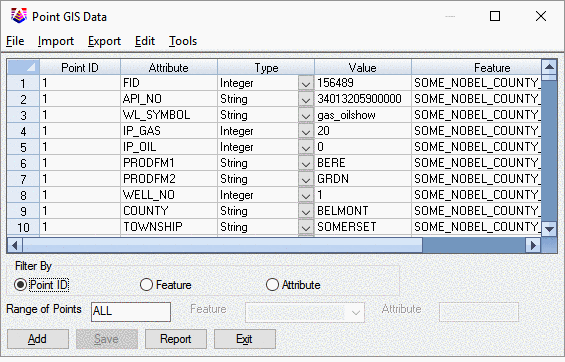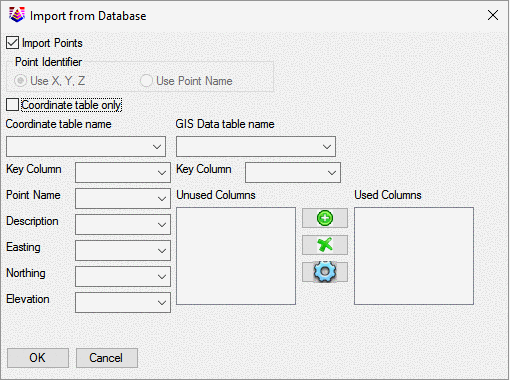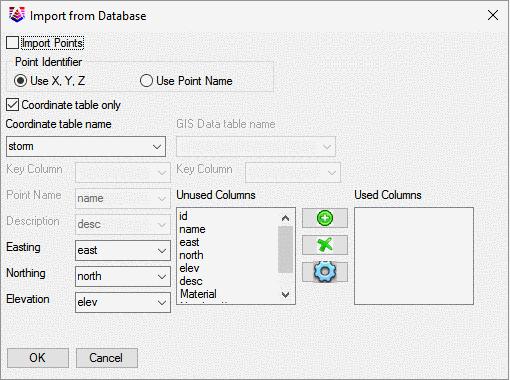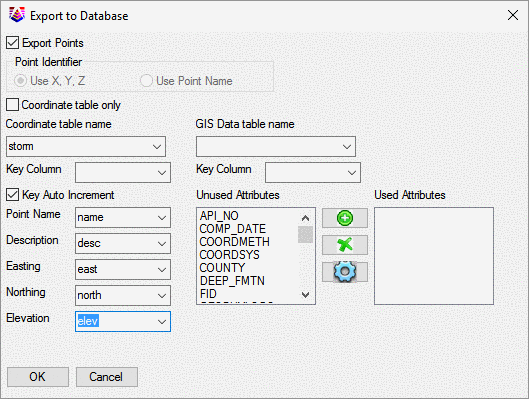Point GIS Editor
This command can be used to import, export, edit and report GIS
data for points. The GIS data is stored in the current coordinate
file which must be set to the CRDB format. To set this
format, go to Points > Set Coordinate File and enter a file name
with the .CRDB extension. To change a current coordinate file into
CRDB format, go to Points > Coordinate File Utilities.
The program uses a spreadsheet for the GIS data sorted by point
number. Each GIS record contains a point name, attrbute name, data
type, value and feature. The Point ID references a point name with
x, y, z and description from the coordinate file. The Attribute is
the name of the GIS data. The Type is the data type of String,
Integer for whole numbers and Double for numbers that can have
decimals. The Value is the actual GIS data value. The Feature is
the name for a set of attributes. For example, Manhole could be a
Feature name and the Manhole feature could have Attributes like
material, size, condition, etc. The Feature name is
optional.
The Filter By settings control the data shown in the
spreadsheet. The Point ID method allows displaying data for a
specified set of points. The Feature method displays data for the
specified feature. The Attribute method displays data for the
specified attribute.
You can edit directly in the spreadsheet. Use the Add and Delete
functions to add or delete records from the spreadsheet. The Save
function saves the GIS data to the CRDB. The Report function uses
the Report Formatter to make a custom report of the GIS
data.
The Import/Export menu has import/export functions to transfer
various data with CRDB. These methods are described below. The Edit
menu has Find, Replace, Delete Row, Delete Range functions.
The Tools menu has a special function to add or subtract a GIS
attribute value to the coordinate file elevations such as
converting the rim elevations in the coordinate file to inverts by
subtracting the depth attribute.
Import from SurvCE GIS Attributes(VTT)
SurvCE stores GIS attribute data in a .VTT file. This file
contains point numbers, attribute name, value and feature name
which imports directly to the CRDB.
Import from Carlson Link
This method imports GIS data assigned to entities with the GIS
Settings > Single File Database.
Import from ESRI SHP File
The SHP method imports from the ESRI SHP file. The import
options include selecting which GIS attribute to use for the
coordinate file point name, description and elevation. There is
also a setting to convert the ESRI SHP lat/lon coordinates to grid
coordinates which requires the grid projection to be already
defined in the Drawing Setup command.
The MSC method reads the ESRI MSC data that is assigned to
drawing entities.
Import from Google Earth File
This function reads GIS data contained in Google Earth KML or
KMZ files. The program converts the lat/lon coordinates from the
Google file into grid coordinates which requires the grid
projection to be already defined in the Drawing Setup command.
Import from Trimble
This import takes a CSV file in Trimble format with point name
and coordinates followed by attributes. All the data for a point is
on the same row in the file and all values are separated by
commas.
Import from Text
This function reads a CSV text file.
Import from Database
Step 1: Setup DB connection
Data Source Name = Specifies the name of the ODBC data
source (DSN). The drop box contains all available DSN in the local
host. Please see how to setup DSN at the end of this document.
User Name = Specifies the user name required to login to the
RDBMS. (Optional)
Password = Specifies the password required to login to the
RDBMS. (Optional)
Usually, DSN is sufficient to connect to the db, but there is
some special case that user name and password are also needed. So
User name and password are optional.
Note: need to hide the password.
Notes: 64 bits application will use 64 bits ODBC drivers. It is
possible to connect 64 bits application to 32 bit ODBC driver, but
it requires additional setup using ODBC-ODBC Bridge.
http://www.easysoft.com/support/kb/kb01026.html
Click OK button to continue setup or Cancel button to exit
Step 2: Setup Data matching
Import Points – import points or skip them.
Point Identifier – use for identify points between the user
data and CRDB coordinates. If the Import Points toggle box is not
selected, then the dialog will prompt user to select the point
identifier, either ‘Use X, Y, Z’ or ‘Use Point Name’.
Use X, Y, Z = use coordinate x, y, z value to identify point.
Use point Name – use point name to identify point.
Coordinate table only - coordinate table contains both
coordinate info and GIS Data
Coordinate table name = the table name of the coordinates
stored in the user db.
Key Column = a column which will uniquely identify a
point.
GIS Data table name = the table name of the GIS data stored
in the customer’s database. This table name will also be used as
feature name in the CRDB.
Key Column = a column which will uniquely link to the
coordinate table.
Currently, there are 6 fields in CRDB coordinates table, P, N, E,
Z, D. P stands for Point Name. N stands for Y-coordinate. E stands
for X-coordinate. Z stands for elevation. D stands for description.
The Dialog uses Point Name, Description, Easting, Northing, and
Elevation to represent the CRDB five columns.
If the ‘Import Points’ toggle box is selected, then all five fields
will be enabled and list the name of the column in the coordinate
table. The user needs to select corresponding column name. Column
name could be used only once in these five field.
If the toggle box is not selected and if ‘Use X, Y, Z’ is selected,
then ‘Easting’, ‘Northing’, and ‘Elevation’ will be enabled.
Otherwise, only ‘Point Name’ will be enabled.
The ‘Unused Columns’ and ‘Used Columns’ are used for selection of
the columns in the GIS Data table. The default content of ‘Unused
Columns’ contains a list of columns in the GIS Data table. The user
can Add/Delete/Setup each by selected it.
The Setup Button will allow user to setup the association between
CRDB GIS Data attributes and the user database.
Step 3: Setup attributes
Column name = name of the column in the GIS Data table
Attribute Name = name of the CRDB GIS Data attribute.
This column contains a foreign key = If the value of the column
doesn’t contains actual data, but only a reference, then it
contains a foreign key. For instance, a DB has a table name
‘company’ and a table name ‘well’. A well belongs to a company, and
a company has many wells. ‘company’ contains an ID and a name. A
well will use the company ID to identify a company. In order to
import the company name to the CRDB, the user needs to provide the
name of the referenced table, the name of the foreign key and the
name of the storage column.
Referenced table name = name of the referenced table
Key Column = name of the referencing key. This combo box
contains all columns in the referenced table.
Corresponding Column = name of the column that data actually
store. This combo box contains all columns in the referenced
table.
If this toggle box is not selected, then actual data is stored in
the GIS Data table.
Note: If user selected the same column for the Key Column and
Corresponding Column, then just ignore the referenced.
Import ESRI File GeoDatabase to CRDB
Step 1: Select File GeoDatabase Directory
Step 2: Setup Data matching
It has similar interface as Import from Database. Please see
Import from Database section for detail.
Export CRDB to a database
Step 1: Setup a db connection – this step is the same as
import data from a database
Step 2: Setup data matching
It is similar to import data from a database. Except the
following,
Key Auto Increment –the user database will automatically increment
the point identifier when a new point is inserted. If this toggle
box is not selected, then the CRDB’s point name will be used as the
primary key. Then the Key Column and Point Name have to be the same
column.
Instead of setup column, export function has to setup column. The
Attributes list box contains a list of available attribute in CRDB
GIS Data table. In order to setup the column, first, the user has
selected an attribute name, and then clicks on setup button
Step 3: Setup the column name
Attribute Name = the name of attribute name in the CRDB GIS Data
table.
Column Name = the name of column name in the user’s GIS Data
table.
This attribute has to be translated to a reference = data has to be
translated and use the foreign key’s value to store in the user’s
GIS Data table.
Corresponding column = the name of column that will match the value
of the attribute
Key column = the name of column that will be the referenced key and
stored in the user’s GIS Data record.
Click OK button when complete setup. Cancel button to cancel and
exit.
Export CRDB to ESRI File GeoDatabase
Note: make sure the GeoDatabase dataset/table is
editable.
It has similar interface as export to a database.
How to setup Data Source
To add and configure a new ODBC data source in a Windows
environment, use the ODBC Data Source Administrator.
To open the ODBC Administrator from the Control Panel:
Step 1: Right click Start > Control Panel.
Step 2: Select Administrative Tools, then select either ODBC
Data Sources (32 bits) or ODBC Data Sources (64 bits).
Step 3: In the ODBC Data Source Administrator dialog box,
click Add.
The Create New Data Source dialog box appears.
Step 4: Select a driver (e.g., PostgreSQL ODBC Driver) and
then click Finish.
The driver configuration dialog box appears.
Step 5: Complete the following field entries:
Data Source Name: enter the name of the data source you want to
access. It can be any valid name that you choose.
Description: enter the description needed for the data source.
Host or Server Name (or IP): enter the name of the PostgreSQL
server host that you want to access. By default, it is
localhost.
Database Name: enter the name of the PostgreSQL database that you
want to use as the default database.
User name: enter your PostgreSQL username (your database user
ID).
Password: enter your password.
Port: enter the port number if it is not the default value
(5432).
Step 6: Click OK to add this data source.
Pulldown Menu Location: GIS Data
Keyboard Command: gis_pt_editor
Prerequisite: Current coordinate file set to CRDB format
